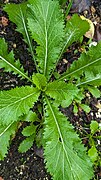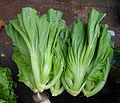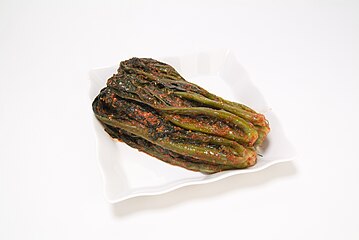| Brassica juncea | |
|---|---|

| |
| Scientific classification | |
| Kingdom: | Plantae |
| Clade: | Tracheophytes |
| Clade: | Angiosperms |
| Clade: | Eudicots |
| Clade: | Rosids |
| Order: | Brassicales |
| Family: | Brassicaceae |
| Genus: | Brassica |
| Species: | B. juncea |
| Binomial name | |
| Brassica juncea (L.) Czern. | |
Brassica juncea, commonly mustard greens, brown mustard, Chinese mustard, Indian mustard, Korean green mustard, leaf mustard, Oriental mustard and vegetable mustard, is a species of mustard plant.
Cultivar
Brassica juncea cultivars can be divided into four major subgroups: integrifolia, juncea, napiformis, and tsatsai.
Integrifolia
| Group | Image | Description | |
|---|---|---|---|
| leaf mustard (芥菜) |
leaf mustard (芥菜) |

|
The leaf mustard is known as "bamboo mustard", "small gai choy" (小芥菜), and "mustard cabbage". |
| Korean red mustard (적갓) and green mustard(청갓) |

|
The mustard plant produces deep purple-red leaves(적갓) and green leaves(청갓) with green petiole. | |
| Japanese giant red mustard (タカナ, 高菜) |

|
The giant-leafed mustard, also known as "Japanese mustard", "takana" (タカナ, 高菜), has purple-red savoy leaves with strong, sharp, peppery taste. | |
| snow mustard (雪里蕻) |

|
Previously identified as B. juncea var. foliosa and B. juncea subsp. integrifolia var. subintegrifolia. The mustard plant is known as "red-in-snow mustard", "green-in-snow mustard" and "xuělǐhóng / hsueh li hung". | |
| curled-leaf mustard | 
|
Previously identified as B. juncea subsp. integrifolia var. crispifolia. The mustard plant is known as "curled mustard", "American mustard", "Southern mustard", "Texas mustard", and "Southern curled mustard". | |
| cut-leaf mustard | mizuna (ミズナ, 水菜) |

|
Previously identified as B. juncea subsp. integrifolia var. japonica. |
| large-petiole mustard | large-petiole mustard | 
|
|
| horned mustard | Previously identified as B. juncea subsp. integrifolia var. strumata. The mustard plant has a "horn" in the center of its stem, thus its name, "horned mustard". | ||
| head mustard | head mustard | 
|
Previously identified as B. juncea subsp. integrifolia var. rugosa. The primary varieties are Swatow (dai gai choy, heart mustard cabbage, wrapped mustard cabbage) and Bamboo (jook gai choi). |
Juncea
| Group | Image | Description | |
|---|---|---|---|
| oil-seed mustard | canola | 
|
Oil seed cultivars of B. juncea subsp. juncea, along with oil seed cultivars of the related species B. napus and B. rapa, are referred to as canola. Other common names include "brown mustard", "Indian mustard", and "oilseed mustard". The mustard plant is called rai or raya in India. |
Napiformis
| Group | Image | Description | |
|---|---|---|---|
| root mustard | root mustard | Previously identified as B. juncea subsp. napiformis. The mustard plant is known as "root mustard", "large-root mustard", "tuberous-root mustard", and "turnip-root mustard". | |
Tsatsai
Uses
Nutrition
| Nutritional value per 100 g (3.5 oz) | |||||||||||||||||||||||||||||||||||||||||||||||||||
|---|---|---|---|---|---|---|---|---|---|---|---|---|---|---|---|---|---|---|---|---|---|---|---|---|---|---|---|---|---|---|---|---|---|---|---|---|---|---|---|---|---|---|---|---|---|---|---|---|---|---|---|
| Energy | 110 kJ (26 kcal) | ||||||||||||||||||||||||||||||||||||||||||||||||||
| Carbohydrates | 4.51 g | ||||||||||||||||||||||||||||||||||||||||||||||||||
| Sugars | 1.41 g | ||||||||||||||||||||||||||||||||||||||||||||||||||
| Dietary fiber | 2 g | ||||||||||||||||||||||||||||||||||||||||||||||||||
| Fat | 0.47 g | ||||||||||||||||||||||||||||||||||||||||||||||||||
| Protein | 2.56 g | ||||||||||||||||||||||||||||||||||||||||||||||||||
| |||||||||||||||||||||||||||||||||||||||||||||||||||
| Other constituents | Quantity | ||||||||||||||||||||||||||||||||||||||||||||||||||
| Water | 92 g | ||||||||||||||||||||||||||||||||||||||||||||||||||
Full Link to USDA Database entry | |||||||||||||||||||||||||||||||||||||||||||||||||||
| Percentages estimated using US recommendations for adults, except for potassium, which is estimated based on expert recommendation from the National Academies. | |||||||||||||||||||||||||||||||||||||||||||||||||||
In a 100-gram (3+1⁄2-ounce) reference serving, cooked mustard greens provide 110 kilojoules (26 kilocalories) of food energy and are a rich source (20% or more of the Daily Value) of vitamins A, C, and K—K being especially high as a multiple of its Daily Value. Mustard greens are a moderate source of vitamin E and calcium. Greens are 92% water, 4.5% carbohydrates, 2.6% protein and 0.5% fat (table).
Cuisine

The leaves, seeds, and stems of this mustard variety are edible. The plant appears in some form in African, Bangladeshi, Chinese, Filipino, Tripuri, Italian, Indian, Japanese, Okinawan, Nepali, Pakistani, Korean, Southern, Taiwanese, and African-American (soul food) cuisines. Cultivars of B. juncea are grown for their greens, and for the production of mustard oil. The mustard condiment made from the seeds of the B. juncea is called brown mustard and is considered to be spicier than yellow mustard.
Because it may contain erucic acid, a potential toxin, mustard oil is restricted from import as a vegetable oil into the United States. Essential oil of mustard, however, is generally recognized as safe by the U.S. Food and Drug Administration. In Russia, this is the main species grown for the production of mustard oil. It is widely used in canning, baking and margarine production in Russia, and the majority of Russian table mustard is also made from B. juncea.
The leaves are used in African cooking, and all plant parts are used in Nepali cuisine, particularly in the mountain regions of Nepal, as well as in the Punjabi cuisine in the northern part of the Indian subcontinent, where a dish called sarson da saag (mustard greens) is prepared. B. juncea subsp. tatsai, which has a particularly thick stem, is used to make the Nepali pickle called achar, and the Chinese pickle zha cai. This plant is called "lai xaak" in Assamese and it is cultivated hugely during the winters. It is eaten in any form in Assam and Northeast, be it boiled or added raw in salad, cooked alone or with pork.
During Taiwanese New Year's Eve, Taiwanese people eat mustard green (Chinese: 長年菜; pinyin: cháng nián cài) as a part of the reunion dinner, symbolizing longevity.
The Gorkhas of the Indian states of Darjeeling, West Bengal and Sikkim as well as Nepal prepare pork with mustard greens (also called rayo in Nepali). It is usually eaten with relish and steamed rice, but can also be eaten with roti (griddle breads). In Nepal it is also a common practice to cook these greens with meat of all sorts, especially goat meat; which is normally prepared in a pressure cooker with minimal use of spices to focus on the flavour of the greens and dry chillies. B. juncea (especially the seeds) is more pungent than greens from the closely related B. oleracea (kale, broccoli, and collard greens), and is frequently mixed with these milder greens in a dish of "mixed greens".
Chinese and Japanese cuisines also make use of mustard greens. In Japanese cuisine, it is known as takana and often pickled for use as filling in onigiri or as a condiment. Many varieties of B. juncea cultivars are used, including zha cai, mizuna, takana (var. integrifolia), juk gai choy, and xuelihong. Asian mustard greens are most often stir-fried or pickled. (See pickled mustard.) A Southeast Asian dish called asam gai choy or kiam chai boey is often made with leftovers from a large meal. It involves stewing mustard greens with tamarind, dried chillies and leftover meat on the bone. Brassica juncea is also known as gai choi, siu gai choi, xiao jie cai, baby mustard, Chinese leaf mustard or mostaza.
-
 Lai shak, mashed potato and fried eggplant
Lai shak, mashed potato and fried eggplant
-
 Fried mustard green dish
Fried mustard green dish
-
 Gat-kimchi, a variety of kimchi made with mustard greens
Gat-kimchi, a variety of kimchi made with mustard greens
-
 Cantonese-style braised mustard greens, with wolfberries
Cantonese-style braised mustard greens, with wolfberries
Green manure
Vegetable growers sometimes grow mustard as a green manure. Its main purpose is to act as a mulch, covering the soil to suppress weeds between crops. If grown as a green manure, the mustard plants are cut down at the base when sufficiently grown, and left to wither on the surface, continuing to act as a mulch until the next crop is due for sowing, when the mustard is dug in. In the UK, mustard sown in summer and autumn is cut down starting in October. April sowings can be cut down in June, keeping the ground clear for summer-sown crops. One of the disadvantages of using mustard as a green manure is its propensity to harbor club root.
Phytoremediation
This mustard plant is used in phytoremediation to remove heavy metals, such as lead, from the soil in hazardous waste sites because it has a higher tolerance for these substances and stores the heavy metals in its cells. In particular, Brassica juncea was particularly effective at removing cadmium from soil. The process of removing heavy metals ends when the plant is harvested and properly discarded. Phytoremediation has been shown to be cheaper and easier than traditional methods for heavy metal reduction in soils. In addition, it has the effect of reducing soil erosion, reducing cross-site contamination.
See also
- Sinapis alba (formerly Brassica alba) – yellow or white mustard, another mustard variety
- Brassica oleracea – wild cabbage
- Brassica nigra – black mustard, another mustard variety
- Brassica rapa – related family of edible greens used in Asian cooking
- Brassica carinata – Ethiopian mustard
- For other edible plants in the family Brassicaceae, see cruciferous vegetables.
References
- "Brassica juncea". Germplasm Resources Information Network. Agricultural Research Service, United States Department of Agriculture.
- Spect, C.E.; Diederichsen, A. (2001). "Brassica". In Hanelt, Peter (ed.). Mansfeld's Encyclopedia of agricultural and horticultural crops (1. Engl. ed.). Berlin: Springer. pp. 1453‒1456. ISBN 3-540-41017-1. Archived from the original on 28 February 2018. Retrieved 20 February 2018.
- ^ Wiersema, John H.; León, Blanca (2013). World Economic Plants: A Standard Reference (2nd ed.). Boca Raton, Florida: CRC Press. p. 112. ISBN 978-1-4398-2142-8. Archived from the original on 28 February 2018. Retrieved 20 February 2018.
- Hutton, Wendy (2004). A Cook's Guide to Asian Vegetables. Singapore: Periplus Editions. pp. 48–49. ISBN 0794600786.
- United States Food and Drug Administration (2024). "Daily Value on the Nutrition and Supplement Facts Labels". FDA. Archived from the original on 2024-03-27. Retrieved 2024-03-28.
- National Academies of Sciences, Engineering, and Medicine; Health and Medicine Division; Food and Nutrition Board; Committee to Review the Dietary Reference Intakes for Sodium and Potassium (2019). "Chapter 4: Potassium: Dietary Reference Intakes for Adequacy". In Oria, Maria; Harrison, Meghan; Stallings, Virginia A. (eds.). Dietary Reference Intakes for Sodium and Potassium. The National Academies Collection: Reports funded by National Institutes of Health. Washington, DC: National Academies Press (US). pp. 120–121. doi:10.17226/25353. ISBN 978-0-309-48834-1. PMID 30844154. Retrieved 2024-12-05.
- Sakorn, P.; Rakariyatham, N. (June 13, 2012). "Biodegradation of glucosinolates in brown mustard seed meal (Brassica juncea) by Aspergillus sp. NR-4201 in liquid and solid-state cultures". Biodegradation. 13 (6): 395–9. doi:10.1023/A:1022851129684. PMID 12713131. S2CID 23927681.
- Polistico, Edgie (2017). Philippine Food, Cooking, & Dining Dictionary. Anvil Publishing, Inc. ISBN 9786214200870.
- ^ "Detention Without Physical Examination of Expressed Mustard Oil". US Food and Drug Administration. 18 March 2011. Archived from the original on 3 March 2016. Retrieved 1 February 2016.
- Grubben, G.J.H. & Denton, O.A. (2004) Plant Resources of Tropical Africa 2. Vegetables. PROTA Foundation, Wageningen; Backhuys, Leiden; CTA, Wageningen.
- Chandrassekaran, V. K. (February 24, 2013). "Flavour of Punjab". The Hindu. Archived from the original on 27 February 2013. Retrieved 6 March 2013.
- 郭冀銘 (2024-02-11). "不只抗癌又護神經 專家曝「長年菜」5大好處 1招降苦味". China Times (in Chinese (Taiwan)). Retrieved 7 January 2025.
- 黃妙雲 (2024-02-07). "降血壓、保眼護膚又助抗癌 年菜必備「長年菜」芥菜營養價值高". United Daily News (in Chinese (Taiwan)). Retrieved 7 January 2025.
- Ghawi, S. K.; Shen, Y; Niranjan, K; Methven, L (2014). "Consumer acceptability and sensory profile of cooked broccoli with mustard seeds added to improve chemoprotective properties". Journal of Food Science. 79 (9): S1756–62. doi:10.1111/1750-3841.12556. PMID 25156799.
- "Kai Choi - Your British Oriental Vegetable Grower". cherryfarms.co.uk. Archived from the original on 2014-05-31.
- "Mustard Green Manure Seeds". greenmanure.co.uk. Archived from the original on February 28, 2018. Retrieved February 28, 2018.
- ^ Naser A. Anjum; et al., eds. (2012). The plant family Brassicaceae contribution towards phytoremediation. Dordrecht: Springer. ISBN 9789400739130.
- Schneider, Thorsten; Haag-Kerwer, Angela; Maetz, Mischa; Niecke, Manfred; Povh, Bogdan; Rausch, Thomas; Schüßler, Arthur (September 1999). "Micro-PIXE studies of elemental distribution in Cd-accumulating Brassica juncea L". Nuclear Instruments and Methods in Physics Research Section B: Beam Interactions with Materials and Atoms. 158 (1–4): 329–334. Bibcode:1999NIMPB.158..329S. doi:10.1016/S0168-583X(99)00356-0.
- Lone, M. I; He, Z. L; Stoffella, P. J; Yang, X. E (2008). "Phytoremediation of heavy metal polluted soils and water: Progresses and perspectives". Journal of Zhejiang University Science B. 9 (3): 210–220. doi:10.1631/jzus.B0710633. PMC 2266886. PMID 18357623.
Further reading
- Everitt, J.H.; Lonard, R.L.; Little, C.R. (2007). Weeds in South Texas and Northern Mexico. Lubbock: Texas Tech University Press. ISBN 0-89672-614-2.
External links
- PROTAbase on Brassica juncea
- Brassica juncea
- " Multilingual taxonomic information". University of Melbourne.
- Mustard Green Manures: Washington State University Extension paper on cover crops.
- "Brassica juncea". Plants for a Future.
| Brassica | |
|---|---|
| Species | |
| Cultivars | |
| Taxon identifiers | |
|---|---|
| Brassica juncea |
|
| Sinapis juncea | |
